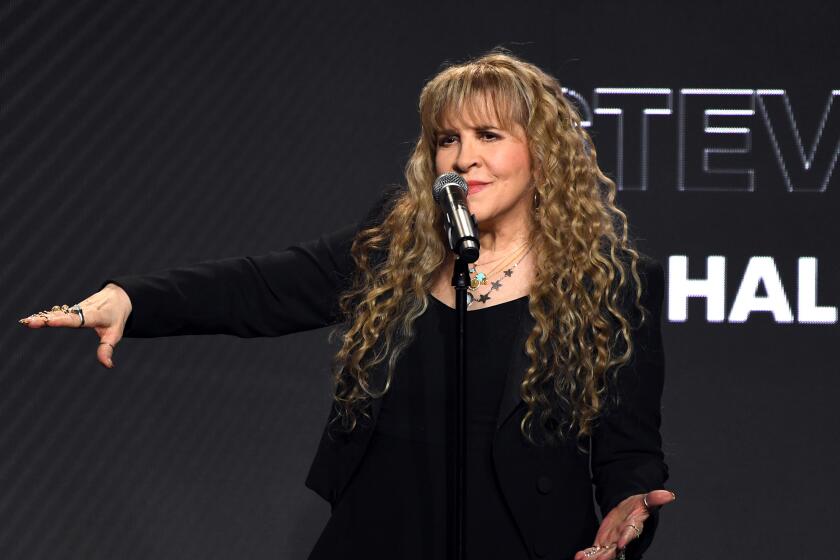The Zydeco Express : American roots music is gaining popularity, according to Louisiana’s Al Rapone, brother of Queen Ida.
- Share via
In his publicity photo, Al Rapone looks a lot like Zorro after retraining. He exchanged his mask for a smile and his sword for an accordion. He’ll use your ears to carve a “Z” in your brain--a “Z” that stands for zydeco as in Al Rapone & the Zydeco Express. Rapone, and his band will drop by to impress and amaze the roots-starved musical aficionados Monday night at Alexander’s in Ventura.
Rapone is different from the typical zydeco virtuoso. First of all, he is from Louisiana, but he’s also a Giants fan (he’s been in the Bay Area since 1946). Rapone was the first zydeco musician to win a Grammy (1982). And he has ties to royalty (Queen Ida is his sister).
Like a teen-ager with a telephone, Rapone has had a tight grasp on that diatonic accordion for a long time. He began playing at church socials as a teen-ager, then took up the guitar and played with blues stars such as Clarence (Gatemouth) Brown, Big Mama Thornton and Jimmy Reed.
He toured for many years with Bobby Freeman, who is remembered by oldies radio and your parents for “Do You Wanna Dance?” Rapone was musical director for his sister the queen before going solo in the early ‘80s. He released a couple of albums in Europe, but not even Columbo could find them anymore. His U.S. debut, “Zydeco to Go” is just out on Blind Pig Records.
In the mid-’40s, before mindless metal on MTV and cable movies full of graphic violence, there was zydeco at the Rapone household in the Bay Area.
“After church when I was a kid, we’d all gather at my mama’s house,” said Rapone in a recent phone interview. “My two uncles and my mama would all pick up those accordions and play. They’d move all the furniture out of the way and the women would go into the kitchen and cook. All the kids would go outside to play fetch with the dogs. I volunteered to help serve the coffee because I wanted to hear the music. That was it for me. Watching dogs fetch--I could do that on Monday.”
San Francisco, said Rapone, is home to a large community of transplanted Cajuns and Creoles.
“Now, San Francisco is the zydeco mecca on the West Coast,” he said. “It’s the first stop in California for zydeco musicians. That’s how it evolved over the years. The Louisiana migration to San Francisco began in 1945-46 because there were four or five shipyards here that were paying a dollar an hour. Back home, they were paying a dollar a day. One of my cousins went to San Francisco, then came back driving a convertible. That did it for us. We moved out here in 1946.”
Rapone found it hard to make a living as an accordion player. He expanded his horizons and became a blues guitarist, played with Freeman for a number of years, and even found time to get fired by Sly Stone.
“One day, I was in the studio and Sly Stone, who was a record producer at the time, shows up. He handed me this chart and I said, ‘What’s this?’ He told me these were the songs we were going to record today. I couldn’t read the chart, plus his brother was waiting in the hall who knew all the songs. Stone put my guitar outside and told me to follow it--he fired me. So I went through my papers and found my G.I. Bill stuff and went back to school.”
While studying music at the College of San Mateo, Rapone formed a trio called the Barbary Coast Good Time Band. About this time (mid-’70s) Rapone hooked up with his sister, just plain Ida before she was promoted to queen. The result was four albums for Queen Ida and the Bon Ton Zydeco Band. Rapone was the vocalist, guitarist, arranger and Grammy winner for the band.
“Ida was always very adaptable. One time at a Mardi Gras party in San Francisco in 1974, she was asked to do a solo. There were at least eight other accordion players there. Anyway, she only knew four songs, but this reviewer was there . . . . That did it. The phone started ringing off the hook. She had always been competitive, but she didn’t know what to do. I told her ‘If you can do it, we can do it.’ And she said, ‘If you think I can do it, I trust you.’ Then she learned six more songs.”
Ida went the royal route after a visit from the King in 1975. No, not Elvis, but the zydeco king, music having plenty of room for royalty.
“I called Clifton Chenier back in Louisiana and asked him to do a gig with us in San Francisco. At that time, he was ‘The King of Zydeco.’ At first, I thought maybe I could be ‘The Prince of Zydeco,’ then I thought, why should I try to hook onto his legacy? I didn’t want to hang onto his coattails. But there was a definite vacancy in the queen department. So I figures, ‘Why be the prince when I could be the bishop and serve the queen?’ That gig with Chenier really helped us both. Over the next few years I produced four albums, wrote all the songs, and arranged them. We terminated our partnership in 1981, but I still play with Ida sometimes.”
While you’d never know it from watching MTV or listening to the radio, American roots music seems to be gaining in popularity. On almost any given night, there’s a blues or zydeco band playing.
“Zydeco is getting bigger,” said Rapone. “It’s growing, growing, growing. The only thing that bothers me are the imitators--all those little zydeco bands that misrepresent our culture. You know, Louisiana was the only territory that was actually a part of Europe. Anyway, I’m hoping to get a Louisiana-oriented song on the charts.”
More to Read
The biggest entertainment stories
Get our big stories about Hollywood, film, television, music, arts, culture and more right in your inbox as soon as they publish.
You may occasionally receive promotional content from the Los Angeles Times.










